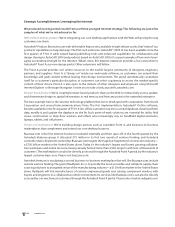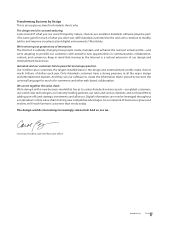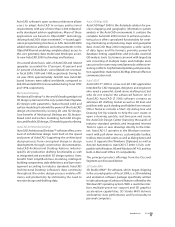Autodesk 2000 Annual Report Download - page 3
Download and view the complete annual report
Please find page 3 of the 2000 Autodesk annual report below. You can navigate through the pages in the report by either clicking on the pages listed below, or by using the keyword search tool below to find specific information within the annual report.
2FY 00 Autodesk, Inc.
Challenges We Faced
Frankly, the light revenues generated by AutoCAD® 2000 software surprised us. We knew, based on the terrific
reception by thousands of test sites and the industry press, that we’d delivered a great product, a great design
platform. And customers told us they planned to buy.
Yet sales of AutoCAD 2000 were soft. We soon identified the reasons why.
Many companies were delaying their planned software purchases for the year,diverting budgets into solving the
Y2K problem.This, of course, affected many companies including Autodesk.
And an unexpectedly high number of customers, current and potential,were waiting for AutoCAD LT® 2000 and
the AutoCAD 2000–based market-specific applications: AutoCAD Architectural Desktop™, AutoCAD® Land
Development Desktop, AutoCAD Map®, AutoCAD® Mechanical, and Mechanical Desktop® software.
Market-Specific Applications: A Matter of Timing
We’re pleased that customers were so interested in our market-specific products. We’ve been working for years
to move them from stand-alone AutoCAD because market-specific products bring in a higher average sales price
and can satisfy a larger customer base.
But we weren’t ready to ship most of these products until the third and fourth quarters. And we didn’t anticipate
just how many customers would wait for them.
Once we did ship the market-specific applications,I have to say, they were very well received.In fact,sales of these
products helped our vertical markets,within our Design Solutions segment,increase revenues by 20 percent over
the previous year:
• Geographic Information Systems (GIS) revenues were up 47 percent.
• Architecture, Engineering, and Construction (AEC) revenues were up 21 percent.
• Manufacturing Design and Information revenues were up 10 percent.
Cost Cutting Promotes Strong Financial Finish
To decrease costs and increase profitability, we reduced our worldwide workforce by 10 percent in the third
quarter—well before sales of the market-specific applications started enhancing revenues. It was the first such
cutback in our history and a difficult time for us all. But I believed then, as I do now, that it was a required step
back to financial health.
Together, the workforce reduction and increased market-specific sales helped boost pro forma operating
margins in the last two quarters. (Pro forma excludes amortization of goodwill and nonrecurring charges,
primarily related to acquisitions and restructuring charges.) Second-half margins climbed to 13 percent,up from
3 percent in the first half; overall, margins finished the year at 8 percent.
We also closed the year with a strong balance sheet: cash, cash equivalents, and marketable securities totaled
$541 million. In addition, we adopted a stock repurchase program for up to 8 million shares and repurchased
approximately 2.9 million shares during the year.
All in all, it was a solid financial finish—just one of many reasons why I’m confident that our position in the
marketplace is healthy and getting healthier.
It’s time to look at our strategic achievements and the great opportunities ahead.
















